
Lisa

Eric
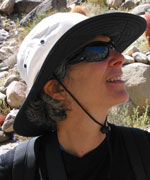
Maude
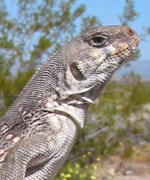
Iggy

Frankel-Engles-Pervere Desert Expedition
Eastern Mojave Desert
7-11 April 2005
In this extraordinary spring, Death Valley--"Mars turned into the Garden of Eden"--is getting all the press, but all across the deserts of California, the results of copious winter rainfall are apparent. Dry lakes are deep in water, creeks are running in the washes, and flowers are everywhere in amazing quantity. If you could make a chain of all the desert dandelions now blooming in the Mojave desert, it would surely reach to the moon and back.
Our basecamp was at the eastern side of the Granite Mountains, in the Eastern Mojave National Preserve. To get there, we drove down 395, turned east on 58, and then continued east on I-40. This route allowed us to see the wildflower displays in the Owens Valley and western Mojave on the way to our destination. On the trip home, we headed north to Baker, skirted Death Valley to the east on 127, entered Nevada, and returned to I-80 via US 95 and 50 in Nevada. This route covered more of the eastern and northeastern sections of the Mojave Desert.
This page describes some of the highlights of our explorations. Scroll down and read what interests you, and don't forget to view the trip slide show. And if you haven't already done so, take a look at the photo essay of our trip to the Anza-Borrego desert in March.
 Lisa |
 Eric |
 Maude |
 Iggy |
|
What We Did When
Thursday
6:45 am -- leave hotel in Bridgeport 1 pm -- blown away by flowers north of Kramer Junction 4 pm -- arrive at campsite 5 - 6 pm -- orientation hike near camp Friday
10:30 am -- hike in Willow Spring Basin 12:30 pm -- begin circumnavigation of Clipper Mountains (via truck) 2:00 pm -- find desert tortoise #1 5:00 - 6:00 -- hike lower parts of Van Winkle Mnts 7:00 pm -- meet Maude, arriving from Las Vegas Saturday
10:30 am -- hike south from camp 11:30-1:30 am -- hike hidden canyon draining Cove Spring area 2 pm -- arrive at Bunny Club 6 pm -- return to camp Sunday
10:00 - 4:30 -- hike Bull Canyon 5 - 7 pm -- hike Kelso Dunes Monday
9:45 am -- break camp 3 pm -- lunch in Tonapah 10:40 pm -- arrive home |
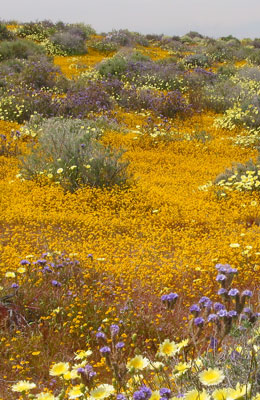
|
|
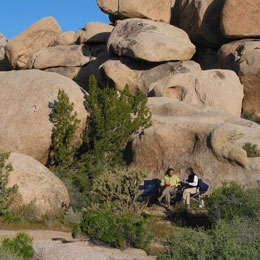 Lisa and Maude enjoy breakfast in a warm, sunny spot |
 Our tent below the big monolithic spire |
Base Camp
Lisa and Eric have camped in hundreds of places throughout California and the
Southwest, and this spot in the Granite Mountains is our favorite among them all.
Granite boulders and monolithic towers define and protect it, and a variety of high-desert
plants--juniper, cholla, yucca, desert peach, grasses, amsinckia--provide refreshing greenery
and animal habitat. It's private, full of life, human-scale yet grand.
|
|
Insects
To desert insects, lots of rain means lots of vegetation,
and lots of vegetation means lots of food for oneself and one's progeny. On Monday,
the stillest day of the trip, we found ourselves in the midst of a butterfly migration
of biblical proportions.
|
 This fat larvae appears about half life-size on your screen |
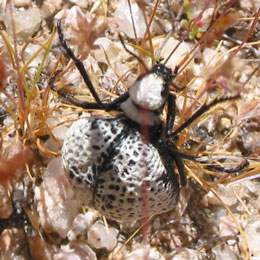 The "tuxedo bug," a walking rattle |
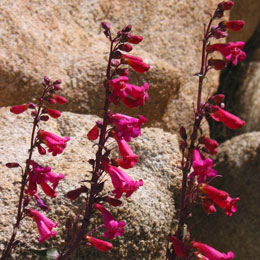 You can't tell in this photo, but the upper leaves are fused around the stem, and the leaf margins are toothed. |
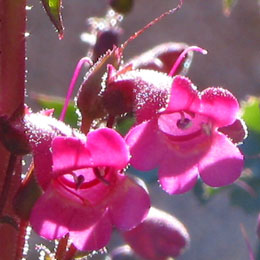 The glandular hairs are evident, and no lines are present on the lower lip. The throat is 6 mm wide or less, and the widely-spreading anther sacs are about 1.0 mm.) |
A rare and endangered Penstemon
On our hike in Willow Spring Basin, we noticed a splotch of magenta amongst the granite boulders.
Eric investigated and found a large penstemon in full bloom. We brought one inflorescence back to the
truck for keying and were surprised to find that we had come across Penstemon stephensii, which is endemic to California
and so limited in distribution (a few desert mountain sites) that the California Native Plant
Society considers it very rare. It is beautiful besides. Eric discovered two other plants in the area.
|
|
Cacti
The beavertail cactus were in flower in almost every community
we visited, and at lower elevations some plants had well over a dozen flowers open at the same time.
We saw a few mound and hedgehog cactus in bloom too. We also saw barrel cactus, several mammilaria, and a Mojave prickly pear.
|
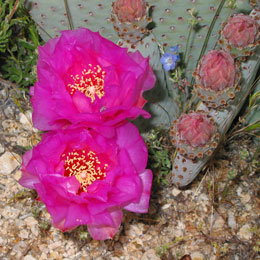 Beavertail cactus (Opuntia basilarus) |
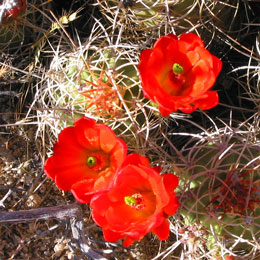 Mojave mound cactus (Echinocereus triglochidiatus) |
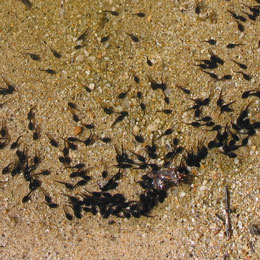 Tadpoles of the Red-Spotted Toad |
 Baby birds (species unknown) in a cholla |
Fecundity
The conditions are excellent for reproduction. The toads have warm, algae-filled pools in which to lay eggs;
birds have abundant insects to feed their chicks; lizards and snakes have moist soil for their eggs. This year
we seem to have missed the festival of toad copulation that we observed last year, but we noticed a number
of egg masses and the tadpoles pictured here.
|
|
Verdure
This is the desert? The Granites have many spots were moisture concentrates, but
this year the greenery in these canyons was like what you'd find in coastal California.
|
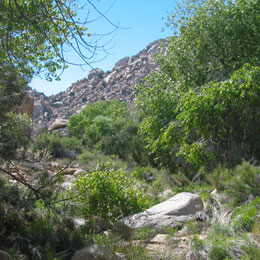 Cottonwoods, shrubs, and grass in the hidden canyon draining Cove Spring |
 Moss on a rock in the wash just south of camp |
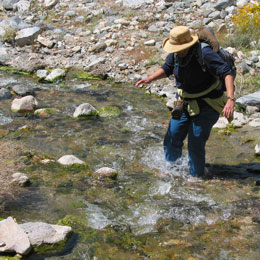 Lisa wades across "Bull Creek" |
 Eric swims in the pool at the entrance to the Bull Canyon narrows |
An Abundance of Water
Bull Canyon drains a large part of the north side of the Granite Mountains, but in a normal year
it is dry below the narrows and holds only a trickle through the narrows. This year, so much water
is draining out of the canyon that you can swim in waist-deep pools, and fording the creek can be
difficult.
|
|
A River in the Desert
There is nothing called "Bull Creek" because only rarely does any water flow in
lower Bull Canyon. But now the canyon holds a full-fledged, noisy creek with a healthy and steady flow.
It shows no sign of drying up anytime soon.
|
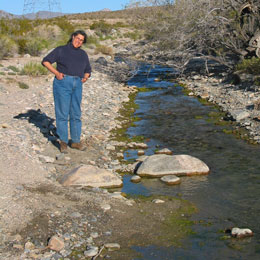 "Bull Creek" is still flowing strong several miles out into the desert! |
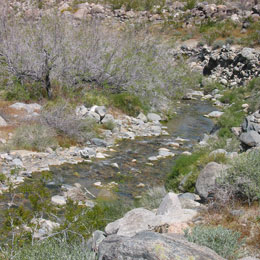 "Bull Creek" flowing in lower Bull Canyon |
 Desert bluebell (Phacelia campanularia) |
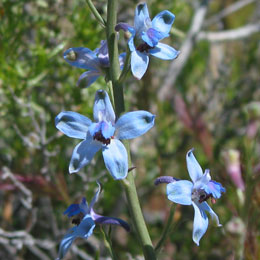 Desert larkspur (Delphinium parishii) |
Blue
Blue is one of the desert's less common colors. The hands-down winner of the best-blue prize
is the desert bluebell, which was growing abundantly in many locations. Many of the
desert bluebell plants were unusually tall (>2 feet).
Other bluish-flowered plants we saw included the lavender-rayed Mojave aster (Xylorhiza),
some Phacelias, Salvia dorii, chia, bladder sage (Salazaria), turpentine broom (Thamnosma montana),
and bluedicks.
|
|
Orange
Orange is also an uncommon desert color. The orange of the
Apricot Mallow is vivid and striking.
|
 Lichen on a rock in the Van Winkle Mnts |
 Apricot Mallow (Sphaeralcea ambigua) |
 Desert gold poppy (Eschscholzia glyptosperma) |
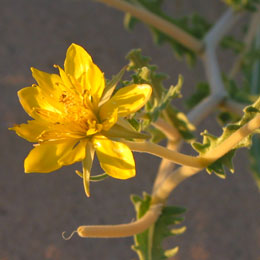 Many-flowered blazing star (Mentzelia multiflora) |
Yellow
Yellow is the most common color in desert flowers (especially in a year like this one, when
the desert flats and bajadas explode in a profusion of mostly-yellow annuals; but scroll down for
photos of that phenomenon). Other yellow-flowered plants we saw include brittlebush (Encelia)
rock pea (Lotus rigidus), bladderpod (Isomeris arborea), a poppy and a blazing star
with a smaller flowers
than the ones pictured here, and many annual members of the sunflower family.
|
|
Pink
Not many desert flowers are pink, but the ones that are
make sure they are noticed through large size (beavertail), vividness (monkey flower), or local
abundance (purplemat). Other pink-flowered plants we saw included sand verbena
(Abronia), beavertail cactus, a gilia, and rhatany (Krameria erecta
|
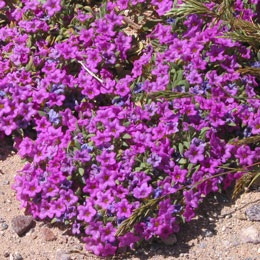 Purplemat (Nama spp.) |
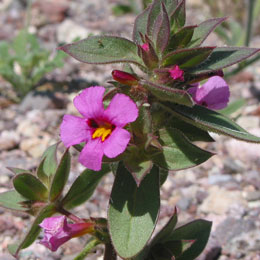 Desert monkey flower (Mimulus bigelovii?) |
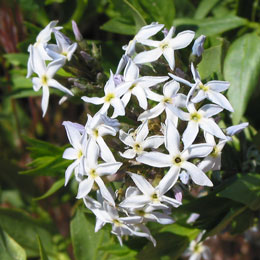 Amsonia tomentosa, a member of the dogbane family (Apocynaceae). There is a single small population at the rhyolite plug in the canyon east of Bull Canyon. |
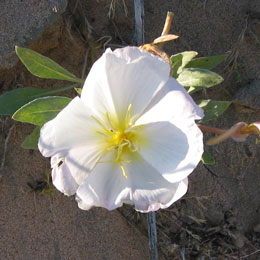 Dune evening primrose (Oenothera deltoides). Common in the sandy areas around Kelso Dunes, and in the stabilized foredunes. |
White
Many of the white-flowered desert plants, like the evening primrose pictured here, have quite large
flowers. Others that passed our notice include the desert lily and
the prickly poppy. Among the abundant annuals are many with white flowers, including
desert chicory, gravel ghost, and desert pincushion.
|
|
Multi-colored and patterned
Are these gorgeous or what? The lilac sunbonnet is very abundant this
year in the gravelly coarse soil on the east side of the mouth of the canyon east of
Bull Canyon. We didn't see any desert five-spots in the eastern Mojave; this one is from the area east
of Death Valley.
|
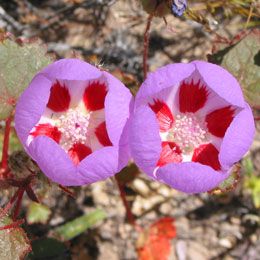 Desert five-spot (Eremalche rotundiflora) |
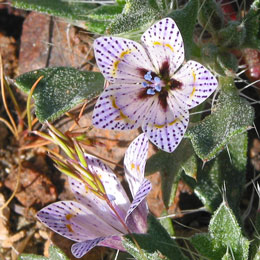 Lilac sunbonnet (Langloisia setosissima ssp. punctata) |
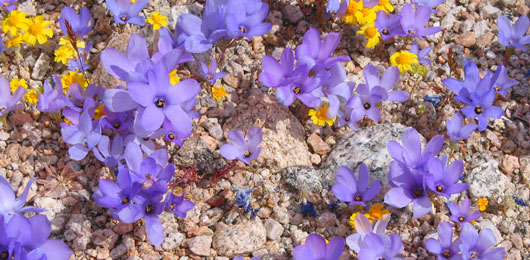 Linanthus parryae in the lower Owen's Valley |
Purplish
South of Bishop along 395 we were treated to colorful carpets of blue and yellow between the shrubs.
Some areas were very dense with this Linanthus, which has both purplish and white forms.
|
|
|
Desert tortoises
On Friday, on our circumnavigation of the Clipper Mountains, we were
at lower elevations (under 3500 feet) and in desert tortoise habitat. Sure enough, we came upon
four tortoises, all mature adults over 1 foot in length. We checked the sex of two, and both were males.
All four decided it was best not to move much while humans were around.
|
 Tortoise #1 |
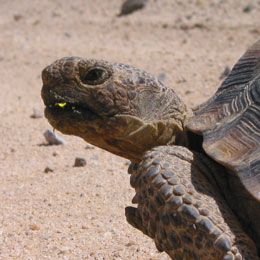 Portrait of tortoise #1 |
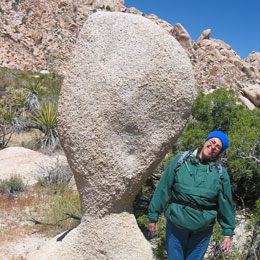 Granite formation with a slim waistline
Granite formation with a slim waistline
|
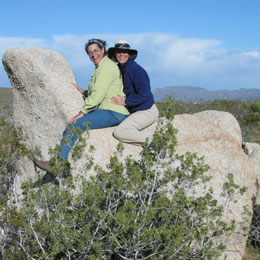 Lisa and Maude ride the horse-rock |
Fun with rocks
South of base camp, the landscape is strewn with weirdly eroded chunks of granite,
many of which (like those pictured) are actually protruding parts of the underlying
basement rock.
|
|
Kelso Dunes
After our hike into Bull Canyon on Sunday, we spent some time at the
Kelso Dunes. The dunes rise more than 600 feet above the desert floor and cover many square miles.
They hold lots of moisture and support a unique ecological community.
|
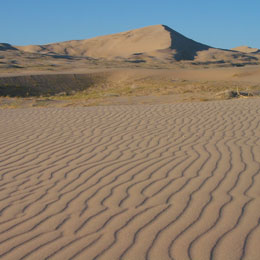 The tallest dune is in the background |
 Around the dunes, creosote bush scrub grades slowly into stabilized dune and then active dune |
 A typical zone of lemon-yellow desert dandelion abundance, somewhere east of Barstow
A typical zone of lemon-yellow desert dandelion abundance, somewhere east of Barstow
|
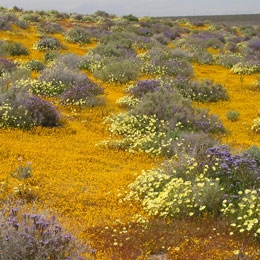 A more diverse assemblage of desert dandelion, goldfields, phacelia, desert chicory, and more, a few miles north of the intersection of 395 and 58. The flowery aroma in this area was almost overwhelming. |
Open desert flower displays
The densest flower displays were at the middle elevations in the open desert and on the bajadas. The dominant
flowers and diversity varied by location, although desert dandelions were almost always part of the mix.
|
|
Herpetofauna
It was a bit chilly for reptiles much of the time, but we saw zebra-tail lizards, Uta, a desert
iguana (pictured here),
and many whiptails, in addition to the tortoises and a few road-killed snakes.
|
 Iggy, the desert iguana |
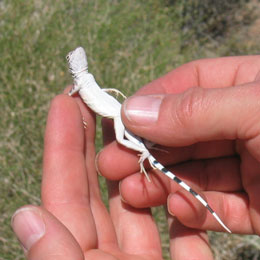 A zebra-tail lizard from last year's trip |
 A single desert lily (Hesperocaulis undulatus)
A single desert lily (Hesperocaulis undulatus)
|
 A typical inter-shrub area, thick with lilies. |
Center of the desert lily universe
In the open desert near Essex, we encountered an area of a few square miles dense with desert lilies. Everywhere
we looked, and out into the near distance, desert lilies filled up the spaces between the shrubs. The average randomly
sited meter-square quadrant would probably include four to six lilies. And this density held for the entire area.
In the more typical drier spring, it's likely that only a small percentage of the desert lily bulbs in this area sprout.
|
|
Carpets other than yellow
Yellow composites made up most of the spectacular flower displays, but we saw flower
carpets in other hues, too.
|
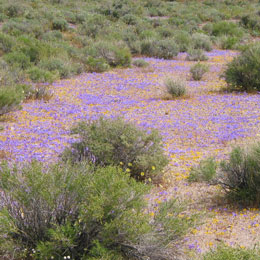 Linanthus parryae in the Owens Valley |
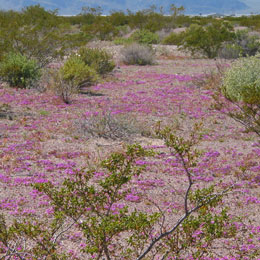 Purplemat (Nama) east of Death Valley |
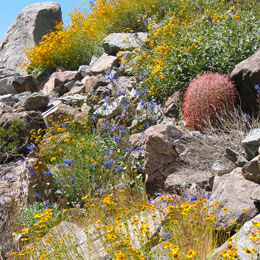 Desert bluebells, brittlebush, and cactus in Bull Canyon
Desert bluebells, brittlebush, and cactus in Bull Canyon
|
 Desert bluebells in Willow Spring Basin |
Cliffside flowers
Some of the most beautiful flower displays were in rocky hillside or cliffside habitats.
|
|
To see more photos (at higher resolution), view the trip slide show. | ||
 | ||

This work is licensed under a Creative Commons Attribution-NonCommercial-ShareAlike 3.0 Unported License | ||